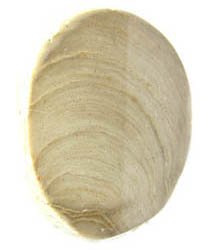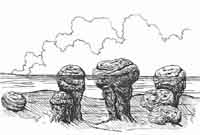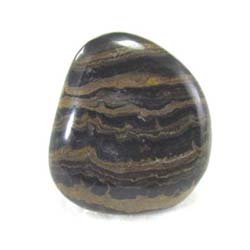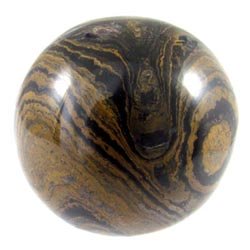Sign up for Lesson Plans, discounts & more!
Stromatolites
Cyanobacteria and Oxygen
Stromatolites are created by cyanobacteria, also called blue-green algae. These microscopic life forms are not really algae at all but bacteria that have the ability to carry out photosynthesis.
It is the process of photosynthesis combined with the growth of the cyanobacteria that creates the distinctive dome-shaped, finely layered rocks we call stromatolites. As the cyanobacteria grows it uses up the carbon dioxide in the surrounding water. That causes calcium carbonate to precipitate or solidify from its dissolved state in the water. The cyanobacteria make some sticky stuff that captures the calcium carbonate and other minerals. These minerals form a crust over the cyanobacteria, which continue to grow around and through the crusty layer. The process forms layer after layer until the classic mushroom shape of the stromatolite raises itself right out of the water.
The remains of these bacteria have created the oldest fossils on earth!
Cyanobacteria have left fossil evidence of their existence in Australia
that is 3.5 billion years old. Notice the B... 3.5 billion years old! This
is remarkable by itself but even more so when you consider that the
oldest rocks that have been dated are 3.8 billion years old.
There
are living stromatalites today but they are very rare. The only known
sites are Shark Bay, Australia, the Bahamas, and the Great Salt Lake, Utah. They were not always
rare though, especially in Precambrian Times. During the Archaean and
Proterozoic cyanobacteria were so abundant that they actually changed
the earth’s atmosphere. They also created oil deposits that we use for
fuel today.
Most living things could not have survived breathing
the air of that time. There was little oxygen and many gases that would
be poisonous. This was transformed because cyanobacteria could
photosynthesize to make its food. The process of photosynthesis uses
carbon dioxide and produces oxygen as a byproduct.
Billions of
cyanobacteria producing oxygen, constantly, over many millions of years
made an atmosphere that could support life as we know it. The beginning
of the Cambrian Period Marked a time of decrease for the stromatolites
but oxygen breathing life forms exploded in the oceans of that period.
Check out some of the Educational Materials for sale on our sister site fossilicious.com.

interested in more? If so, you may want to check out our other sites:
fossilicious.com - Our online fossil and mineral rock shop.
rocksandminerals4u.com - An educational site about rocks, minerals, and geology.
Geologic Time Geologic Time Line
Cenozoic Era
Quaternary
Neogene
Paleogene
Mesozoic Era
Cretaceous
Jurassic
Triassic
Paleozoic Era
Permian
Carboniferous
Devonian
Silurian
Ordovician
Cambrian
Archean Time
Hadean Time
Teachers Resources
Activities for Education and Fun
Earth Science Lesson Plans
Activities For Kids
Fossil Lesson Plans
Fossil Activities
Education Articles
Coloring Pages
Dinosaur Coloring Pages
Montessori Materials
Geology Club
Fossil Hunting
 |
 |
 |








